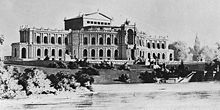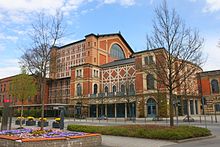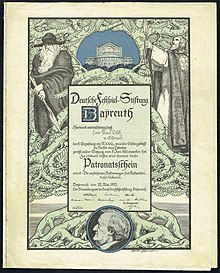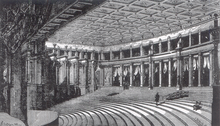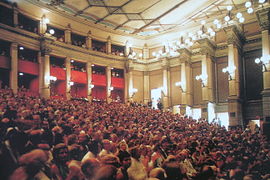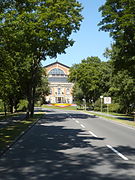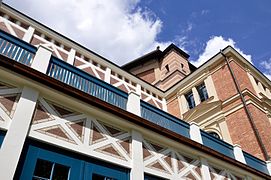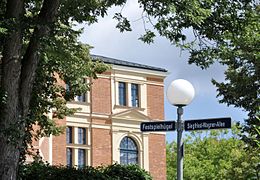Richard Wagner Festival Theater
The Richard Wagner Festival Hall , also known as the Bayreuth Festival Hall , is a festival hall on the Green Hill in Bayreuth . It was in the years 1872-75 by Otto Brückwald designed by Richard Wagner in the style of Hellenistic romance built. Unlike many opera houses , it does not have a permanent ensemble and is performed every year from July 25th to August 28th as part of the Bayreuth Festival with operas and musical dramas by Wagner in 30 performances. It is considered to be one of the opera houses with the world's best acoustics.
Building history
Suggestions
Richard Wagner received his first suggestions for his future festival theater, as his Riga biographer Carl Friedrich Glasenapp claimed, during his time as Kapellmeister in Riga (1837/39). The theater there is said to have already had many elements of the Bayreuth Festival Hall: a steeply rising parquet floor in the form of an amphitheater , a deep orchestra pit and darkening of the auditorium, which was not common at the time.
As a location for a festival theater in Germany, Wagner probably initially considered Würzburg , where he lived and was choir director in 1833/34.
Wagner's ideas
After completing the poetry of his Ring des Nibelungen , Wagner also formulated his idea of a stage festival in 1851, initially in letters to Franz Liszt , for example , and later also publicly in A Message to My Friends . A “theater festival” should be added to the “singing festivals” and “gymnastics festivals” of the time. The performances should take place in a rather small town in an unadorned and makeshift theater as a one-off event. The theater was then to be torn down again “made of planks and beams”. The auditorium would have to be laid out as an amphitheater and the orchestra would definitely have to be covered.
Wagner was referring to the theater festivals of ancient Greece and the regular Dionysia . The ceiling of the Bayreuth Festival Hall made of painted canvas is reminiscent of the ideal of an open-air theater.
Semper's plans for Munich
When King Ludwig II of Bavaria summoned Wagner to Munich in 1864, the idea of the festival also seemed to be realizing quickly. Gottfried Semper , the architect who was friends with Wagner and builder of the Dresden court theater and, after its fire, also of the new court theater, the Semperoper , was entrusted with the design and implementation of the project.
Semper initially planned a theater to be built into the Munich Glass Palace , then a monumental festival theater high above the banks of the Isar, accessible through a wide boulevard. According to Wagner's wishes, the interior design was already laid out in the same way as in the house that was later realized in Bayreuth: extreme practicality in the auditorium and stage with concentration on the work performed. There should be no box theater arise, but a rising auditorium with good visibility from all seats, a "democratic" auditorium without all class barriers .
When Wagner had to leave Munich in 1865, the Festspielhaus project stalled. Wagner himself soon distanced himself from it, also because the whole project threatened to become too monumental for him, distanced himself more and more from his ideal ideas and evaded his influence, since he was now living in Switzerland.
Construction in Bayreuth

In a conversation lexicon , Wagner discovered the Margravial Opera House in Bayreuth around 1870 . Since it had the largest stage in a German opera house at the time, he hoped to find a suitable venue for his Ring des Nibelungen there and still be able to realize his idea of a stage festival. That is why he came to Bayreuth in April 1871 and visited the historic theater. Due to the small size of the auditorium, he abandoned the plan, but Wagner liked the location and size of the city, so that he immediately initiated concrete preparatory work for a new building. Initially, a plot of land on Stuckberg, near the suburb of Sankt Georgen , was discussed as a building site after an inspection in April 1871. After the failure of the sales negotiations, the city acquired, without Wagner's knowledge, a building site on what is now the Green Hill below the Bürgerreuth. Wagner, annoyed by the development, considered dropping the Bayreuth location again. On January 8, 1872, his local patron Friedrich Feustel and the Mayor of Bayreuth Muncker traveled to Tribschen to change his mind, which they succeeded with Cosima's help.
Wagner received the property on the Green Hill free of charge from the city of Bayreuth. The architectural planning was carried out by Otto Brückwald , with the main features of Semper's plans being retained.
The foundation stone was laid on May 22, 1872 in pouring rain . On this occasion Wagner conducted Beethoven's 9th Symphony in the Margravial Opera House. But then the construction was delayed again and again for financial reasons. The planned sale of 1,000 patronage certificates for 300 thalers each was slow. By the spring of 1876 less than half had been sold. Wagner also hoped in vain for the German Kaiser, the Chancellor and the Reichstag, despite the support of Countess Schleinitz . He received financial help from the Ottoman Sultan Abdülaziz in the amount of around 80,000 euros based on today's purchasing power (2020).
opening
The topping-out ceremony was held on August 2, 1873 , but the first festival planned for 1873 had to be postponed. In 1874, King Ludwig II secured the building with a loan of initially 300,000 marks , which was later increased by another 100,000 marks. The Wagner family later repaid both amounts in full, offsetting royalties .
The Festspielhaus was finally able to open on August 13, 1876 with the Rheingold , which initiated the first cyclical performance of the Ring des Nibelungen . Because of the deficit caused by the first festival, the house was then vacant for six years; the next festival was not held until 1882 with the world premiere of Parsifal . For Ludwig II's visit to the festival in 1882, the building was expanded to include the “Königsbau” at the front, but the shy king no longer attended the festival.
Another story
Weimar Republic
After a ten-year break, the festival again took place in the summer of 1924. The demonstrative political sentiment was new: the old black-white-red imperial flag waved on the Festspielhaus , General Ludendorff and Prince August Wilhelm of Prussia were greeted with healing calls. Adolf Hitler first visited the festival in 1925, and from then on regularly. Thomas Mann called the Festspielhaus "Hitler's Court Theater".
time of the nationalsocialism
In April 1939, on the occasion of Adolf Hitler's 50th birthday, a portrait of the “Führer” several meters high and illuminated at night was emblazoned in front of the central window of the royal building. An eagle was enthroned above it, holding a swastika in its claws, and at least nine other large-format swastikas "adorned" the front.
From 1940 to 1944 the organization Kraft durch Freude organized “War Festival” in the Festspielhaus. Guests who were invited free of charge were soldiers from the front, wounded, nurses and workers from armaments factories. On July 23, 1940, Adolf Hitler came to the Festspielhaus for the last time for the “Festival of Victory”.
Shortly before the end of World War II , in April 1945, Bayreuth was bombed three times by Allied aircraft. In the heaviest of these attacks on April 11, 1945 by British machines, the festival hall was expressly excluded from destruction by the “ Master Bomber ”.
Between the War Festival and Neu-Bayreuth (1945–1951)
After Bayreuth was occupied by American troops in April 1945, the Festspielhaus was initially confiscated. Since it survived the war without being destroyed, it was soon used for musical performances by American troops. A concert by Grace Moore & Martini took place on May 31, 1945 . There were revues, crime comedies and light music. The Bayreuth Symphony Orchestra , which was founded after the war and only existed until December 1948, also gave concerts there. It started with a concert for the 9th US Armored Division on June 24, 1945 . In December, the then 78-year-old Paul Lincke even conducted a concert entitled Music You Love To Hear . In 1946 the symphony orchestra ventured into opera performances. For example, the opera was in June 1946 lowland given at the Festspielhaus.
The neighboring festival restaurant served as a refugee camp in the post-war years. About five hundred people of both sexes and of all ages lived in the two halls, only poorly separated by curtains, under difficult sanitary conditions. It was not until the beginning of 1950 that the last 77 residents were “settled” in the city.
Owners and ownership since the 1970s
The Bayreuth Festival Hall has been supported by the Richard Wagner Foundation Bayreuth since 1973 . The foundation was set up by the Federal Republic of Germany , the Free State of Bavaria , the city of Bayreuth , the Society of Friends of Bayreuth , the Bavarian State Foundation , the Upper Franconian Foundation , the Upper Franconian District and members of the Wagner family who are also members of the Board of Trustees. The managing director of the Board of Trustees is the Lord Mayor of Bayreuth (currently Brigitte Merk-Erbe ).
The foundation is obliged to rent the festival hall to the festival entrepreneur in order to hold the festival; (since 1986) that is the Bayreuther Festspiele GmbH, which was managed (with a lifetime contract) by Richard Wagner's grandson Wolfgang Wagner as managing director. Wolfgang Wagner resigned from his position on August 31, 2008, and the Board of Trustees appointed his two daughters Eva and Katharina Wagner as successors.
Extensive renovation work from the 2010s
From December 2012 to 2016 the festival hall was partially scaffolded as the ailing facade was in need of renovation. The building technology was also in need of modernization. The need for renovation had long been known, but had long been ignored. In March 2014, the financing of the renovation was finally secured, for which around 30 million euros were made available by the Free State of Bavaria and the federal government. In order for the state coffers to be able to cover the costs of the building, a rental agreement between the Richard Wagner Foundation as the owner and Bayreuther Festspiele GmbH , in which Bavaria and the federal government are involved, had to be concluded by 2040, otherwise the investments would be durable not been given. The general renovation by the Cologne architect Detlef Stephan started after the 2015 season and is currently planned for seven years. It should be completed by 2026 at the latest and will take place during the rehearsal and season-free times, which is why there is little time available to carry out the renovation stages. The first stage took place according to plan in spring 2016 before the start of the rehearsal period for the 2016 season. The south facade (including the Königsbau ), which had been provided with protective scaffolding and a tarpaulin since 2012, was renovated. At the same time, the catalog of damage was recorded in the interior of the festival hall. In order to be able to work in winter too, scaffolding heating was installed. The scaffolding could be dismantled for the 2016 season. The second stage could not begin in December 2016 at the latest, as originally planned, because there were legal approval reasons (a special construction as scaffolding was required, for which the shareholders' meeting had only released the funds at the end of November 2016). For the second stage, the renovation of the rest of the stage building (tower), as well as the administration and cloakroom wings was planned. During the renovation break in 2016/17, further preparations were made for the renovation of the interior of the Festspielhaus, whereby it turned out that the original financial concept from 2013 would not cover the costs and a new one had to be set up.
One of the still unsolved problems of the Festspielhaus are the high temperatures that prevail in the auditorium in warm summers.
The house in the media
The festival hall has served as a location for film and television productions several times. In 1954, scenes from the film Magic Fire were created there , and in 2018 the episode A Day Like Any Other in the Tatort television series .
The show with the mouse was also a guest at the Festspielhaus. The festival orchestra, led by Christian Thielemann, played the show's theme song. This was one of the few occasions on which music was played in the Festspielhaus that did not come from Wagner.
Building description
overview
The auditorium and the stage are designed in half-timbered construction, whereby the original wooden framework was replaced by a supporting structure made of concrete and steel during renovations from the 1960s . The exterior is largely made of red brick and has almost no decorative ornamentation, which has earned the house the disrespectful name “ barn ”. With the memory of “fleetingly constructed festival halls”, Wagner said that a folk impression should be created and “imitation of the foreign character” avoided.
stage
The stage portal is 11.80 m high and 13 m wide. The maximum platform width is 27 m. The main stage has a depth of 22 m, there is also a playable back stage 13 m deep. The total length of the theater from the main portal to the end of the back stage is 100 m. The Schnürboden is 26 m, the roof ridge 36.40 m above the stage level. The stage recess has a maximum depth of 13 m.
auditorium
The auditorium consists of completely evenly rising rows of seats modeled on ancient amphitheaters , which guarantees an almost ideal view from almost all seats. Because the floor is supported on a wooden structure and the wooden pillars and columns - these are plastered with plaster to create the impression of stone - there are excellent acoustic conditions. These good acoustics made it impossible to replace the house with a stone building. After various modifications, it offers space for 1974 spectators.
The auditorium is flanked by shear walls. These are continued in a double proscenium , which was created in order to create the optical impression that the stage is further away than it is in reality.
The fact that Wagner participated intensively in the planning of the theater building from the beginning led to numerous innovations for practical theater reasons. In addition to the design of the auditorium, this also includes the Wagner curtain , a stage curtain that opens upwards and to the side like an iris diaphragm .
visibility
One of Wagner's particular concerns was the darkening of the theater space, because nothing should distract the audience from what was happening on the stage. However, it was more or less by chance that it was completely dark: The new type of gas lighting in the auditorium was only finished on the day of the first performance in the Festspielhaus and could no longer be tried out or adjusted. This ultimately led to the fact that the light was not slowly dimmed at the beginning of the performance, but the lighting went out completely, so there was total darkness. This was retained, as the effect met Wagner's intentions. This broke with the theater practice of the 18th and 19th centuries, in which the auditorium was illuminated and, at best, only bathed in a moderate semi-darkness.
The structural consequence of Wagner's idea, who did not want the "effort of sound generation" to remain visible, was a sound cover over the orchestra pit, which also had the task of preventing light reflections from the orchestral musicians' desk lights from reaching the auditorium typical Bayreuth mixed sound .
Mystical abyss
Richard Wagner called the distance between the first and second proscenium the “mystical abyss”, in which the sound cover over the orchestra pit hides the orchestra in the Bayreuth Festival Hall, which is invisible to the audience . The covert orchestra was supposed to reinforce the stage illusion by preventing any distraction from the stage and the "disgusting disruption caused by the constantly intrusive visibility of the technical apparatus". The “ideality” of the scene should be separated from the “reality” of the audience in order to put the audience “into the excited state of clairvoyance”.
The wooden sound cover consists of two parts: a horizontal sound screen, which is attached to the front edge of the stage and almost completely covers the orchestra pit from behind, and a shell-shaped screen between the orchestra pit and the auditorium, which reflects the sound rising forward from the orchestra pit towards the stage and prevents direct sound in the auditorium.
The atypical and globally unique orchestra pit leads in the form of a terrace on six steps down to the back and under the stage and is completely invisible to the audience. The conductor sits elevated but still below the modesty panel in front of the orchestra and is the only person in the Festspielhaus, which can immediately be realized stage and orchestra pit. This exclusively indirect sound in the auditorium results in a mixed sound that makes it practically impossible to localize not only individual instruments but the entire orchestra. Instead, an orchestral sound is achieved that spreads "omnipresent" in the room.
The covered orchestra pit also has very practical effects: Since the sound of the violins only reaches the listener indirectly, their primary task is to give the singers musical support. For this reason, the different seating arrangements prescribed by Wagner are observed: the first violins, which have the lead voice in the orchestra, are not seated as usual on the left, but on the right of the conductor, so that the sound openings of their instruments (and not those of the second violins) are at an angle from the auditorium away and point directly to the stage. The arrangement of the strings is reversed compared to the seating arrangement in the German arrangement , which regularly leads to confusion for the conductors.
This peculiarity also means that the festival choir is conducted from the side of the stage with flashlights. The choir director follows the conductor on a screen in order to be able to follow his tempo specifications and variations immediately; the beats themselves occur significantly later than the orchestra conducting due to the sound mix on the stage.
Difficult hall acoustics
The effects of the “mystical abyss” on the acoustics are discussed controversially. The acoustics of the hall are described by various opera listeners as “outstanding” and “unique”, whereby enthusiasm for Wagner's works can play a decisive role.
Due to the position and shape of the orchestra pit and the sound cover, the sound of the orchestra is directed into the stage area like a " nozzle " and reflected on the backdrops, fixtures and rear wall ( stage prospect ) of the stage, then mixed with a proportion of direct sound into the auditorium to get. The orchestral sound is definitely changed by the stage design.
The following effects can be perceived:
- The sound of the instruments mixes and localization within the sound body becomes impossible. Overlays and comb filter effects create distortions that affect the typical sound of the instruments. For example, it becomes difficult to separate the double basses and timpani in terms of sound.
- When the curtain is closed (e.g. during the overture of a piece), the sound directed through the sound cover onto the stage is radiated against the frequency-dependent absorbing curtain, so that a different sound is produced when the curtain is opened and closed.
- The simple plywood stalls in the hall are still an acoustic problem. Unoccupied seats with the raised seats provide reflectors that audibly influence the sound of the hall depending on the occupancy. Modern acoustically optimized seating could help. If the hall is half empty, unpleasant reverberation, sometimes flutter echo, can be heard.
Controversial effect
In connection with the mystical abyss, the philosopher Theodor W. Adorno coined the famous phrase “covering production through the appearance of the product”. He accused the illusion machine of Wagner's manipulation, saw in it a premonition of the culture industry and denounced a “ regression on magical thinking under late capitalism ”.
The concealment and transfiguration of manufacturing processes has significance beyond Wagner in the aesthetics of the 19th century and is also evident in other arts, for example in the painstakingly produced weightlessness in the romantic top dance . The concealment and simultaneous assumption of writing in the language understanding of that time, which Jacques Derrida described, goes in this direction: It should not be noticed that here people are not speaking freely but reading.
In the media theory of the past few years, the “mystical abyss” as a principle of dividing and hiding has found attention again, for example in comparison to the diorama by Louis Daguerre . Wagner's idea of switching off everything that was disruptive was taken up in the 20th century by film and the emerging cinemas and implemented in a similar way.
Extension buildings
The festival hall has been expanded over the years with a few outbuildings, which serve as rehearsal and workshop rooms during the year and sometimes accommodate the catering trade during the festival season.
In the neighborhood
Weatherproof information boards have been set up on the Green Hill and its area rising to the Festspielhaus, which under the heading Silent Voices depict numerous singers of Wagner roles in a short biography with photos. A bronze bust for Richard Wagner was also set up in Richard Wagner Park, and in 1979 a bust for Cosima Wagner , designed by Arno Breker, on the side of the park interrupted by the access road . In 1996, an art sculpture The Dream, created and donated by the Japanese Setsuzo Matsusaka, was placed on the rising hill , on the pedestal of which a handwritten note by Richard Wagner is engraved. The square in front of the entrance area was named Wolfgang-Wagner-Platz , the street that leads directly to the main building is called Siegfried-Wagner-Allee. The streets leading around are named Wotanstraße, Parsifalstraße, Tannhäuserstraße, Rheingoldstraße and refer to Wagner's works.
literature
- Richard Wagner: The Bayreuth Theater Festival Theater. In addition to a report on the laying of the foundation stone. Fritzsch, Leipzig 1873 ( digitized version )
- Richard Wagner: The Bayreuth Theater Festival Theater. In: Collected Writings and Seals. Volume 9. 4th edition. Siegel, Leipzig, 1907, pp. 322-344
- Heinrich Habel : Festspielhaus and Wahnfried. Prestel, Munich 1985
- Markus Kiesel : The Richard Wagner Festspielhaus Bayreuth. nettpress, Cologne 2007, ISBN 978-3-00-020809-6
- Hans-Jürgen Fliedner: Architecture and experience - the Bayreuth Festival Hall. Synästhesie-Verlag , Coburg 1999, ISBN 3-931248-05-4
- Carl-Friedrich Baumann : Stage technology in the Bayreuth Festival Hall (100 years of the Bayreuth Festival). Prestel Verlag , Munich 1980, ISBN 3-7913-0493-3
- Zdenko von Kraft : The Festspielhaus in Bayreuth: On the history of his idea, his career and its completion. 3rd revised edition. Festival management publisher, Bayreuth 1969
- Dietrich Mack : Bayreuth Festival. The idea, the construction, the performances. 22nd edition. Publishing house of the Bayreuther Festspiele GmbH, Bayreuth 1988
- Frank Piontek : Richard Wagner - The Bayreuth Festival Theater: Insights into a phenomenon; audiotransit , Bayreuth 2014, audio book, EAN 4260070930119
Web links
- Bayreuth Festival
- Richard Wagner Festival Hall at the Bavarian State Office for Monument Preservation
- Richard Wagner Festival Theater. In: Structurae
- Innsbrucker Nachrichten, May 28th, 1872: The foundation stone is laid for the Wagner Theater
Individual evidence
- ^ Oswald Georg Bauer: Richard Wagner in Würzburg. The beginning of a theatrical broadcast. Michael Imhof, Petersberg 2004, ISBN 3-937251-78-2 .
- ^ Würzburgerleben: Richard Wagner's house .
- ^ Richard Wagner: About the naming music drama. In: Ders .: Collected writings and poems . 4th edition. Röder, Leipzig 1907, Vol. 9, p. 307.
- ^ W. Bronnenmeyer: Richard Wagner. Citizens in Bayreuth . Ellwanger, Bayreuth 1983, p. 46 f .
- ^ W. Bronnenmeyer: Richard Wagner. Citizens in Bayreuth . Ellwanger, Bayreuth 1983, p. 49 .
- ↑ Mustafa Armağan: Osmanlı tarihinde Maskeler ve Yüzler. Timaş Yayınları, İstanbul 2007, ISBN 975-263-116-9 ( excerpt in German translation ).
- ↑ The Turkish Sultan as sponsor: Crescent moon over the green hill. BR-online from August 11, 2009
- ↑ Karl Müssel: Bayreuth in eight centuries . 1st edition. Gondrom, Bindlach 1993, ISBN 3-8112-0809-8 , p. 192 f .
- ↑ Karl Müssel: Bayreuth in eight centuries , S. 204th
- ↑ Bernd Mayer: Bayreuth in the twentieth century , p. 66.
- ↑ Bernd Mayer: Bayreuth April 1945 . 1st edition. Wartberg, Gudensberg-Gleichen 2004, ISBN 3-8313-1463-2 , p. 18th f .
- ↑ Bernd Mayer: Bayreuth April 1945 , p. 41.
- ^ Albrecht Bald: The Bayreuth Symphony Orchestra and the Festspielhaus 1845-1948. The rise and fall of an Upper Franconian post-war orchestra. In: Archive for the history of Upper Franconia. Bayreuth 2002, 82nd volume;
- ↑ Bernd Mayer: “Where every tenth person owned a chair” in the Heimatkurier des Nordbayerischer Kurier, 3/2004, pp. 14–15
- ↑ Deed of foundation of May 2, 1973 PDF, 600 kB
- ↑ Nordbayerischer Kurier online from December 3, 2012: The festival hall is scaffolded , accessed on March 2, 2014.
- ↑ At the Bayreuth Festspielhaus the plaster is crumbling
- ^ InFranken: Money can flow for the renovation of the Bayreuth Festival Hall, March 20, 2014.
- ↑ Management report on the general renovation .
- ↑ Festspielhaus: Well-timed construction site .
- ↑ Redevelopment of the Bayreuth Festival Hall on br.de ( Memento from November 17, 2015 in the Internet Archive )
- ↑ Redevelopment is delayed , Bayerischer Rundfunk , August 26, 2016.
- ^ Clear the way for the second construction phase , notification from Festspiel-GmbH, November 23, 2016.
- ↑ Refurbishment stop until autumn 2017 BR-Klassik , November 24, 2016.
- ↑ See and Die Bayreuth in: Nordbayerischer Kurier from February 1, 2019, p. 13.
- ^ BR Klassik: Festival orchestra plays "mouse" melody. BR Klassik , online portal, July 24, 2019. Accessed July 28, 2019 .
- ↑ The show with the mouse. Twitter channel, July 22, 2019, accessed July 22, 2019 .
- ^ Richard Wagner: Bayreuth (Das Bühnenfestspielhaus). In: Ders .: Collected writings and poems . 4th edition. Röder, Leipzig 1907, Vol. 9, p. 326.
- ^ Richard Wagner: Bayreuth (Das Bühnenfestspielhaus). In: Ders .: Collected writings and poems . 4th edition. Röder, Leipzig 1907, Vol. 9, p. 342.
- ^ Richard Wagner: Bayreuth (Das Bühnenfestspielhaus). In: Ders .: Collected writings and poems . 4th edition. Röder, Leipzig 1907, Vol. 9, p. 336.
- ^ Richard Wagner: Bayreuth (Das Bühnenfestspielhaus). In: Ders .: Collected writings and poems . 4th edition. Röder, Leipzig 1907, Vol. 9, p. 338
- ↑ Josef Zaglmann: The "Lord of Voices" in Bayreuth , onetz.de of August 22, 2006, accessed on August 6, 2019.
- ↑ Gert-Dieter Meier: The Little Times Tables for Festival Novices , Nordbayerischer Kurier from July 18, 2012, accessed on August 6, 2019.
- ^ Theodor W. Adorno: Attempt on Wagner . In: Ders .: Collected writings . Scientific Book Society, Darmstadt 1998, vol. 13, p. 82.
- ↑ Theodor W. Adorno: Theses against occultism . In: Ders .: Collected writings . Scientific Book Society, Darmstadt 1998, vol. 4, p. 274.
- ↑ On-site inspection at the end of May 2019, photos can be posted.
Coordinates: 49 ° 57 ′ 35 " N , 11 ° 34 ′ 47" E

